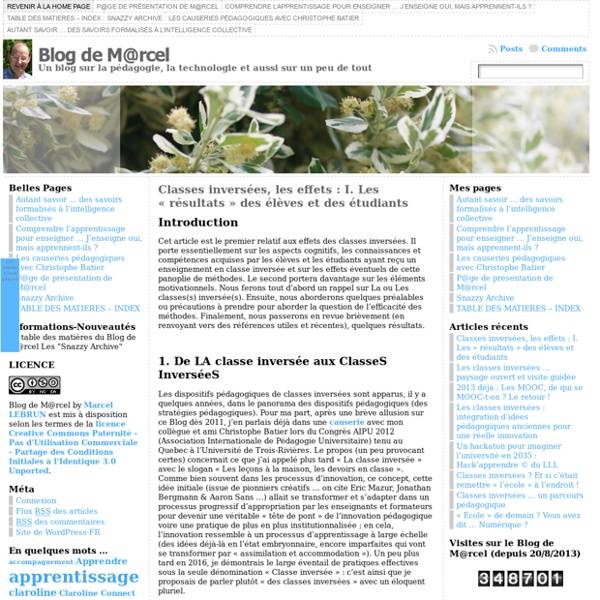



http://lebrunremy.be/WordPress/
Related: hongmeima • TraAM • Formation • Pedagogie & formation • PEDAGOGIE8 Project-Based Learning Tips For Teachers 8 Project-Based Learning Tips For Teachers contributed by Rachelle Dene Poth My first year of teaching with project-based learning provided as much learning for me as it did my students. Each year when I head back to my classroom in the fall, I have many ideas of new methods, new tools, and some changes that I want to make in my classes. These changes and ideas are the result of attending summer conferences, reading new books, and maybe the most helpful, student feedback that I review over the summer. The biggest change I wanted to make this year was to have my students really engage in Project-Based Learning.
The Flipped Classroom Guide for Teachers As technology becomes increasingly common in instruction at all levels of education from kindergarten to college, the modern classroom is changing. The traditional teacher-centered classroom is falling away to give students a student-centered classroom where collaborative learning is stressed. One way educators are effectively utilizing online learning and changing the way they teach is by flipping their classrooms. What is a Flipped Classroom?
The Best Leaders Are Constant Learners As Juan Manuel Fangio exited the chicane before the blind Tabac corner in the 1950 Monaco Grand Prix, he stomped on the brake. It was a counterintuitive reaction for a racing driver exiting a corner — but one that likely saved his life. By slowing down he avoided plowing into a multi-car pile-up, which was just out of sight beyond the turn. In racing folklore, Fangio’s evasive action is considered a miracle. CancelEditDeletePreviewrevert Text of the note (may include Wiki markup) Could not save your note (edit conflict or other problem). Please copy the text in the edit box below and insert it manually by editing this page. Upon submitting the note will be published multi-licensed under the terms of the CC-BY-SA-3.0 license and of the GFDL, versions 1.2, 1.3, or any later version. See our terms of use for more details.
Authentic assessment - Institute for Teaching and Learning Innovation - University of Queensland Adams Becker, S, Brown, M, Dahlstrom, E, Davis, A, DePaul, K, Diaz, V & Pomerantz, J, (2018) NMC Horizon Report: 2018 Higher Education Edition. EDUCAUSE, Louisville, CO. Retrieved from 50 Ways To Use Bloom's Taxonomy In The Classroom 50 Ways To Use Bloom’s Taxonomy In The Classroom by Terry Heick Bloom’s Taxonomy is a powerful teaching and learning tool that can help you shape nearly everything that happens in your classroom. Why you would want to do this is another conversation, though I will say that, in brief, Bloom’s places the focus on student thinking and observable outcomes, and that is useful in formal learning contexts.
6 Expert Tips for Flipping the Classroom Tech-Enabled Learning | Feature 6 Expert Tips for Flipping the Classroom Three leaders in flipped classroom instruction share their best practices for creating a classroom experience guaranteed to inspire lifelong learning. By Jennifer Demski01/23/13 "If you were to step into one of my classrooms, you'd think I was teaching a kindergarten class, not a physics class," laughs Harvard University (MA) professor Eric Mazur. "Not because the students are children, but because of the chaos and how oblivious the students are to my presence." What Google Learned From Its Quest to Build the Perfect Team So Rozovsky started looking for other groups she could join. A classmate mentioned that some students were putting together teams for ‘‘case competitions,’’ contests in which participants proposed solutions to real-world business problems that were evaluated by judges, who awarded trophies and cash. The competitions were voluntary, but the work wasn’t all that different from what Rozovsky did with her study group: conducting lots of research and financial analyses, writing reports and giving presentations.
Distractions tempt us at every turn, from an ever-growing library of Netflix titles to video games (Animal Crossing is my current vice) to all of the other far more tantalizing things we could be doing instead of doing what actually needs to be done. Is there any hope to focus on the things that matter in a world that wants us to do everything all the time? Spoiler: the answer is yes. Nir Eyal, avid Pocket user and author of Hooked: How to Build Habit-Forming Products and Indistractable: How to Control Your Attention and Choose Your Life, sat down with us to share his insights on how to beat distraction and stop feeling guilty about watching YouTube videos or playing Animal Crossing on your downtime.